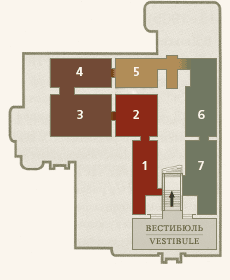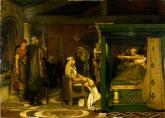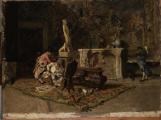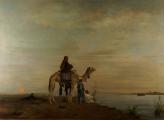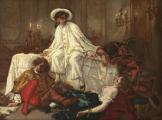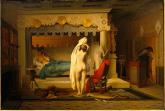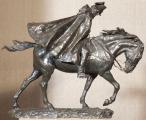The Paris Salon is one of France's most prestigious art exhibitions, the official regular display of the Paris Academy of Fine Arts. Founded by a decree of Louis XIV, the Paris Salon played a key role in the artistic life of the capital for two whole centuries, and participation in its exhibitions was compulsory for .my painter who wished to become famous. The selection of works was made by a special jury set up by governmental decree. In the nineteenth century similar salons were opened in other major European centres as well. In the middle of the nineteenth century almost every artist paid tribute to salon painting, which, unlike many other artistic trends at the time, was international in spirit and contained none of the clearly expressed differences of national schools. In spite of the fact that in its striving to impress salon art was occasionally somewhat superficial and eclectic, many artists displayed works of great artistic merit at the Salon.
Thus Thomas Couture's Supper after the Masked Ball (1850s-1860s) skillfully combines what was then an extremely popular subject from the Italian commedia dell'arte with allusions to the customs and morals of the day, which would have been easily understood by his contemporaries. Historical art also developed within the framework of salon art, combining a careful study of historical costumes and everyday details with intriguing subjects from life in "the old days". "From the beginning of the nineteenth century writers and artists sought to endow their works with authentic features and what became known as 'local colour'. Up till then it had not been accepted either on the .stage or in painting to worry about authentic reproduction of customs, dress or objects [...]. But when actors and artists decided to reproduce not only human feelings, but also the people themselves in their real form, they began to strive for the utmost accuracy in recreating the situations and customs of day," wrote the theoretician of architecture Eugene Emmanuel Viollet-le-Duc. This group includes works by the Dutch-born British painter, Lawrence Alma-Tadema Fredegund by the Deathbed of Bishop Praetextatus (1864) and Jean-Leon Gerome's King Candaules (1859). Pictures on oriental themes were also extremely popular with the public. Leon Bonn's Eastern Barber's Shop (1872), Eugene Fromentin's Waiting for the Ferryboat across the Nile (1872) и и I Mariano Fortuny у Carbo’s Snake Charmers (1870) appeared as a result of their и travels round the Near East.
In the middle of the century many German artists went to Paris, where they became acquainted not only with the work of the Barbizon School, but also with that of Salon painters. In Germany itself during this period local artistic centres were formed around the academies of Dusseldorf and Munich. At a time when professors of the Dusseldorf school were giving priority to accurate drawing and careful working of details, Munich artists were painting in a much freer manner, paying attention mainly to the overall pictorial treatment. The studios of the two brothers Andreas and Oswald Achenbach, who worked at the meeting point of Romanticism, Realism and Salon painting, were particularly well-known in Dusseldorf.
Genre scenes from the life of ordinary people became a separate subject in German realism. Ludwig Knaus's The Morning after the Festival (1853) belongs to this category. Such works lacked a dramatic element or clearly expressed social message. Exponents of this trend usually adopted the standpoint of an objective observer, focusing attention mainly on the pictorial rendering of the subject.


